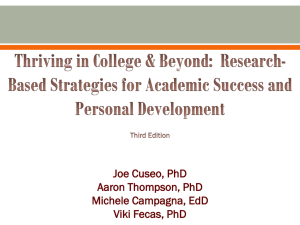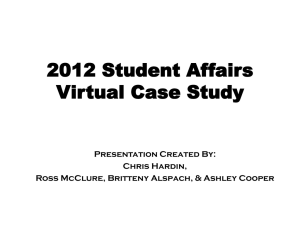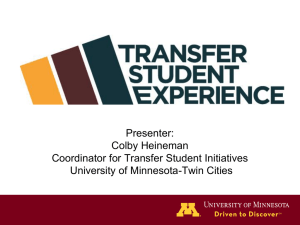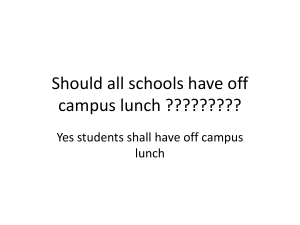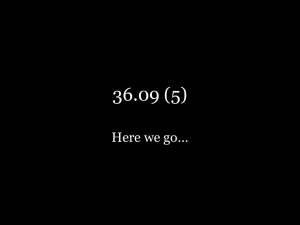What All First-Year Students Should Know
advertisement
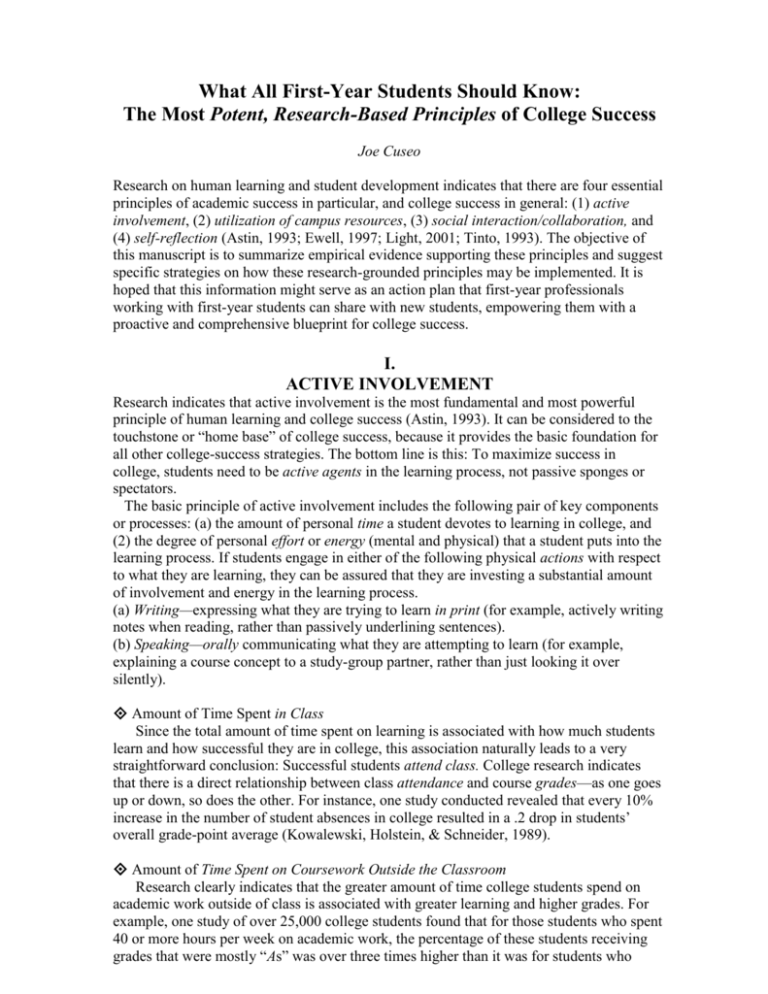
What All First-Year Students Should Know: The Most Potent, Research-Based Principles of College Success Joe Cuseo Research on human learning and student development indicates that there are four essential principles of academic success in particular, and college success in general: (1) active involvement, (2) utilization of campus resources, (3) social interaction/collaboration, and (4) self-reflection (Astin, 1993; Ewell, 1997; Light, 2001; Tinto, 1993). The objective of this manuscript is to summarize empirical evidence supporting these principles and suggest specific strategies on how these research-grounded principles may be implemented. It is hoped that this information might serve as an action plan that first-year professionals working with first-year students can share with new students, empowering them with a proactive and comprehensive blueprint for college success. I. ACTIVE INVOLVEMENT Research indicates that active involvement is the most fundamental and most powerful principle of human learning and college success (Astin, 1993). It can be considered to the touchstone or “home base” of college success, because it provides the basic foundation for all other college-success strategies. The bottom line is this: To maximize success in college, students need to be active agents in the learning process, not passive sponges or spectators. The basic principle of active involvement includes the following pair of key components or processes: (a) the amount of personal time a student devotes to learning in college, and (2) the degree of personal effort or energy (mental and physical) that a student puts into the learning process. If students engage in either of the following physical actions with respect to what they are learning, they can be assured that they are investing a substantial amount of involvement and energy in the learning process. (a) Writing—expressing what they are trying to learn in print (for example, actively writing notes when reading, rather than passively underlining sentences). (b) Speaking—orally communicating what they are attempting to learn (for example, explaining a course concept to a study-group partner, rather than just looking it over silently). Amount of Time Spent in Class Since the total amount of time spent on learning is associated with how much students learn and how successful they are in college, this association naturally leads to a very straightforward conclusion: Successful students attend class. College research indicates that there is a direct relationship between class attendance and course grades—as one goes up or down, so does the other. For instance, one study conducted revealed that every 10% increase in the number of student absences in college resulted in a .2 drop in students’ overall grade-point average (Kowalewski, Holstein, & Schneider, 1989). Amount of Time Spent on Coursework Outside the Classroom Research clearly indicates that the greater amount of time college students spend on academic work outside of class is associated with greater learning and higher grades. For example, one study of over 25,000 college students found that for those students who spent 40 or more hours per week on academic work, the percentage of these students receiving grades that were mostly “As” was over three times higher than it was for students who 2 spent 20 or less hours per week on academic work. On the other hand, among students who spent 20 or fewer hours on academic work, the percentage of them receiving grades that were mostly “Cs” or below was almost twice as high as it was for students who spent 40 or more hours per week on academic activities (Pace, 1990a; 1990b). Active Listening and Note-Taking in Class In college, students will find that professors frequently use the lecture method, which places great demands on their ability to listen carefully and take notes effectively. Research shows that, in all subject areas, the majority of test questions on college exams come from the professor’s lectures and that students who take better class notes get better course grades (Brown, 1988; Kierwa, 2000). The best way for students to apply the strategy of active involvement during a class lecture is to engage in the physical action of writing notes. Writing down what the instructor is saying in class essentially “forces” students to pay closer attention to what is being said, and “reinforces” their retention (memory) of what has been said. Active Reading Outside of Class Just as writing promotes active listening in class, writing also promotes active reading outside of class. Recording notes on what is being read while it is being read ensures active involvement, because it involves more mental and physical energy than merely reading the material, or passively underlining sentences with a magic marker. II. UTILIZING CAMPUS RESOURCES College success, like any human behavior, is influenced by both the individual and the individual’s environment. The student’s environment (college campus) is chock full of specialized resources that are available to them in print, on line, and in person, which can strongly support their quest for educational and personal success. Research indicates that students who utilize these resources report higher levels of satisfaction with the college experience and get more out of the college experience. For example, in a comprehensive review of over 2500 research studies, the following conclusion was reached: “The impact of college is not simply the result of what a college does for or to a student. Rather, the impact is a result of the extent to which an individual student exploits the people, programs, facilities, opportunities, and experiences that the college makes available” (Pascarella & Terenzini, How College Affects Students, pp. 610-611). In particular, students who use the following campus resources are more likely to be successful. Learning Center or Academic Support Center Studies show that students who become actively involved with academic support services outside the classroom, such as the Learning Center or Academic Support Center, are more likely to attain higher college grades and complete their college degree, particularly if they began their involvement with these support services during the first year of college (Cuseo, 2003). It has also been found that students who seek and receive assistance from academic-support services show significant improvement in academic selfefficacy—that is, they develop a greater sense of personal control over their academic 3 performance and develop higher self-expectations for future academic success (Smith, Walter, & Hoey, 1992). Despite the multiple advantages of getting involved with academic support services outside the classroom, these services are typically under-utilized by college students, especially by those students who could gain the most from using them (Knapp & Karabenick, 1988; Walter & Smith, 1990). This could be due to the fact that some students feel that seeking academic help is an admission that they are not “smart” or that they cannot succeed on their own. College Library Successful students do not overlook the fact that librarians are educators from whom they can learn as they do from classroom instructors. Furthermore, the library is a place where students can acquire skills for locating, retrieving, and evaluating information that may be applied to any course they are taking or will ever take. Thus, these are versatile and transferable research skills that students can continually apply throughout their college experience. As the English author, Dr. Samuel Johnson once said, “The next best thing to knowing something is knowing where to find it.” Academic Advisement College students who have developed a clear sense of their educational and career goals are more likely to continue their college education and complete their college degree (Willingham, 1985; Wyckoff, 1999). However, most beginning college students need help with clarifying their educational goals, selecting an academic major, and exploring future careers. For instance, consider the following findings: (a) three of every four beginning college students are uncertain or tentative about their career choice (Frost, 1991); (b) less than 10% of new students feel they know a great deal about their intended college major (Erickson & Strommer, 1991); (c) over half of all students who enter college with a declared major change their mind at least once before they graduate (Noel, 1985); and (d) only one of three college seniors end-up majoring in the same field that they preferred during their first year of college (Cuseo, 2005). These findings point to the conclusion that college students’ do not make final decisions about their major before starting their college experience; instead, they make these decisions during the college experience. Career Development Center Research on college students indicates that they are more likely to stay in school and graduate when they have some sense of how their present academic experience relates to their future career goals (Levitz & Noel, 1989). Research also shows that the vast majority of new students are uncertain about what future careers they would like to pursue (Gordon & Steele, 2003). Counseling Center Students entering college today are reporting higher levels of stress than in years past (Astin, Parrot, Korn, & Sax, 1997). The first year in college can be stressful because it represents a major life transition, which requires not only academic adjustments, but also involves significant changes in social relationships, emotional experiences, and personal identity. In fact, studies show that the vast majority of students who withdraw from college 4 do not do so for strictly academic reasons, that is, most students who “drop out” do not “flunk out,” but leave because of other factors (Tinto, 1993). These findings point to the importance of students’ focusing not only on their academics, but also on “non-academic” aspects of their adjustment to college and their development as a “whole person.” In fact, studies of successful people in the “real world” indicate that social and emotional intelligence (“EQ”) are often more important for personal and professional success than intellectual ability (IQ) (Goleman, 1995). Experiential Learning Resources The positive impact associated with student use of these resources is supported by the work of two highly regarded scholars, who reviewed more than 2500 studies on college students, and reached the following conclusion: “On the basis of the extensive body of evidence reviewed, one of the most inescapable conclusions we can make is that the impact of college is largely determined by the individual’s quality of effort and level of involvement in both academic and nonacademic [experiential] activities” (Pascarella & Terenzini, 1991). There are two major ways students can get involved in college life beyond academics and capitalize on experiential learning opportunities outside of the classroom: (a) through involvement in co-curricular (extra-curricular) experiences on campus, and (b) through college-sponsored service learning (volunteer) experiences in the local community. 1. Co-curricular (“Extra-curricular”) Experiences on Campus. Colleges and universities no longer refer to involvement in campus life outside the classroom as “extra”-curricular activities, because these can be very powerful sources of experiential learning. Thus, they are referred to as “co”-curricular experiences, because the prefix “co” suggests that they are equal to curricular (course-related) experiences for promoting learning. More specifically, research reveals that students who become actively involved in campus life are more likely to (a) enjoy their college experience, (b) graduate from college and (c) develop leadership skills that are useful in the “real world” of work after college (Astin, 1993). For example, college graduates consistently report that their participation in co-curricular experiences involving leadership helped them to develop skills that were important for their work performance and career advancement. These reports have been confirmed by on-the-job evaluations of college alumni, which indicate that previous involvement in co-curricular activities on campus, particularly those involving student leadership, is the best predictor of successful managerial performance. In fact, these experiences are more strongly associated with the managerial success of college graduates than the “prestige” of the college they attended (Pascarella & Terenzini, 1991). Also, involvement in student leadership activities is associated with improved self-esteem for both men and women (Astin, 1993). Furthermore, students who participate in co-curricular experiences usually earn better grades than non-participants, as long as they do not “overdo” it. A good rule-of-thumb is to spend no more than 15-20 hours per week working in co-curricular activities, and to get involved in no more than 2-3 major campus organizations at any one time. 2. Service Learning (Volunteer) Experiences in the Local Community When students volunteer to serve others, they are also serving themselves; in addition to boosting their self-esteem by knowing that they are doing something “good” or doing the 5 “right thing,” volunteering also enables them to (a) acquire learning skills through hands-on experience (hence the term, “service learning”), (b) strengthen their resumé, and (c) explore areas of work that may relate to their future career interests. Service-learning experience can function as an “exploratory” internship that enables students to “test the waters” and gain real-life knowledge about careers relating to their area of volunteer work, while simultaneously providing them with career-related work experience. Such experience also allows them to network (connect) with professionals outside the college who may serve as excellent resources, references, and sources for letters of recommendation. Furthermore, if these professionals are impressed with a student’s initial volunteer work, they may also turn out to be the students’ future employer. Furthermore, research indicates that college students who are involved in co-curricular, volunteer, and part-time work experiences outside the classroom that total no more than 1520 hours per week actually earn higher grades than students who do not get involved in any out-of-class activities at all (Erickson & Strommer, 1991; Pascarella, 2001). This is probably due to the fact that students who have commitments outside the classroom learn to manage their out-of-class time better, because their structured out-of-class schedule essentially “forces” them to use their time well. On the other hand, students who do not have to show up for anything other than their 13 hours of classes per week may have so much unstructured (“free”) time outside the classroom that they do not get into a regular routine for organizing it. So, instead of effectively using their out-of-class time, they end up wasting or abusing it. III. SOCIAL INTERACTION & COLLABORATION Learning is strengthened when it takes place in a social context that involves human interaction. As some scholars put it, human knowledge is “socially constructed” or built-up through interaction and dialogue with others. According to these scholars, our thinking is largely an “internalization” or internal incorporation of the conversations we have had with other people, and our personal knowledge is largely a product of these interpersonal interactions (Bruffee, 1993). So, if we have frequent, high-quality dialogue with others, we increase the quality of our thinking and the quantity of our knowledge. Four particular forms of social interaction have been found to be strongly associated with improving students’ performance in college and their motivation to complete college: (a) student-faculty interaction, (b) student interaction with academic advisors, (c) student interaction with a mentor, and (d) student-student (peer) interaction. Student-Faculty Interaction Many research studies have shown that students’ college success is influenced heavily by the quality and quantity of their interaction with faculty members outside the classroom. More specifically, student-faculty contact outside of class is positively associated with the following student developments: (a) improved academic performance, (b) increased critical thinking skills, (c) greater satisfaction with the college experience, (d) increased likelihood of completing a college degree, and (e) stronger desire to seek further education beyond college (Astin, 1993; Pascarella & Terenzini, 1991). Student-Advisor Interaction An academic advisor can be an effective referral agent who is in a position to direct students to, and connect them with, campus support services that best serve their needs. An 6 advisor can also help students understand college procedures and navigate the bureaucratic maze of college policies and politics. Interaction with a Mentor Research in higher education is beginning to demonstrate that a mentor is someone who can make students feel “significant” and who can encourage or enable them to stay “on track” until they complete their college degree (Campbell & Campbell, 1997). A mentor can assist students in trouble-shooting difficult or complicated issues that they may not be able to resolve on their own. A mentor is also someone with whom students can share good news, such as their success stories and personal accomplishments. There are many other people on campus who have the potential to be outstanding mentors, such as the following: - Academic advisors - Faculty in the student’s intended major - Juniors, seniors, or graduate students in the student’s intended field of study - Working professionals in careers that interests the student - Career counselors - Personal counselors - Learning assistance professionals (for example, Learning Resource Center) - Student Development professionals (for example, Office of Student Life) - Residential Life advisors - Service-learning professionals - Financial aid counselors or advisors - Campus minister. Interaction with Peers (Student-Student Interaction) Research on college students repeatedly points to the importance of the peer group as a powerful source of social and intellectual support. One study of over 25,000 college students revealed that, when students interact with each other while learning, they achieve higher levels of academic performance and are more likely to complete their college degree (Astin, 1993). Peer interaction is especially important during the first term of college, because this is a stage in the college experience when feeling socially accepted and “belonging” are highpriority needs for new students—many of whom have left the long-time security of their family and hometown friends. Studies repeatedly show that students who have become “socially integrated” or “connected” with other members of the college community are much more likely to complete their first-year of college and continue on to complete their college degree (Tinto, 1993). Collaboration with Peers Research on students from kindergarten through college has shown that when students collaborate in teams, their academic performance and interpersonal skills improve significantly (Cuseo, 1996). One way in which students can do this is by participating in learning communities, in which the same group of students takes the same block of courses together during the same academic term. Research shows that students who participate in learning community programs are more likely to: (a) become actively involved in classroom learning, (b) form their own learning groups outside the classroom, (c) report greater intellectual gains, and (d) continue their college education (Tinto, 1997, 2000). 7 IV. SELF-REFLECTION Student success requires not only action, but also reflection—that is, reflecting on what they have done, what they are doing, and what they will do. Such reflection or thoughtful review is the flip side of active involvement. Both processes are needed for learning to be complete. Active involvement is necessary for engaging attention—which enables students to initially get information into their brain, and reflection is necessary for consolidation— keeping that information in their brain, by locking it into their long-term memory. In fact, researchers have discovered that there are different brain-wave patterns are associated with each of these two essential processes of human learning (Bradshaw, 1995). There are four specific forms of self-reflection that are particularly important for effective learning and college success: (1) self-assessment, (2) self-monitoring, (3) reflecting on feedback, and (4) reflecting on one’s future. Self-Assessment Simply defined, self-assessment is the process of evaluating one’s personal characteristics, traits, or habits, and their relative strengths and weaknesses. This process is essential for promoting self-awareness, which is a critical first step toward selfimprovement, strategic planning, and decision-making. Listed below are key characteristics of the “self” that can strongly influence college success, and therefore, are important target areas for student self-assessment. 1. Personal Interests: what you like or enjoy doing. 2. Personal Values: what is important to you; what you care about doing. 3. Personal Abilities or Aptitudes: what you do well or are have the potential to do well. 4. Learning Habits: how you go about learning—the usual approaches, methods, or techniques you use to learn. 5. Learning Styles—how you prefer to learn, that is, your preferred manner of: (a) receiving information (e.g., reading from books or listening to speakers), (b) perceiving information (e.g., through sight, sound, or touch), and (c) processing information—how you tend to deal mentally with information that you have received and perceived (e.g., thinking alone about it or talking about it with others). 6. Personality Traits: your temperament, emotional characteristics or social tendencies (for example, whether you tend to be an introvert or extrovert). 7. Academic Self-Concept: your personal beliefs about what kind of student you think you are, and how you perceive yourself as a learner. In particular, two components of academic self-concept play an important role in college success: (a) Academic Self-Efficacy—the degree to which students believe that they are in control of their own academic fate. That is, whether they think their academic success depends largely on themselves (their self-motivation and self-determination) and that they can change for the better (by increasing their effort and improving their habits); or, whether they believe that academic success depends largely on factors beyond their control (e.g., their upbringing or present life circumstances), and that they cannot change or improve their performance (e.g., due to low ability or insufficient intelligence). (b) Academic Self-Esteem—how you feel about yourself as a student (e.g., 8 positive, negative, or neutral) and your level of self-confidence in academic situations (e.g., whether you expect success or fear failure). Self-Monitoring Research indicates that one key characteristic of successful college students is that they monitor their own performance, that is, they maintain awareness of (a) how effectively they are learning—for example, they pay attention to whether they are really paying attention in class, and (b) if they are actually learning what they are attempting to learn—for example, if they are truly understanding the material they are studying or merely memorizing it (Weinstein, 1994; Weinstein & Meyer, 1991). As part of this self-monitoring process, successful students also maintain awareness of what they are attempting to learn (for example, science or literature) and they self-regulate or adjust their learning strategies in a way that best meets the specific demands of the subject they are trying to learn (Pintrich, 1995). For instance, they read more slowly and stop to test their understanding more frequently when reading technical material in a science textbook than when reading a novel in a literature course. In contrast, unsuccessful students often do not maintain this high level of self-awareness during the learning process, which can result in their not being fully aware of what method they are using to learn, whether the method they are using is most effective for the type of material they are attempting to learn, or if they are actually understanding the material they are attempting to learn. Successful students engage in a level of reflective thinking that involves a deeper level of understanding than “surface” memorization of factual knowledge. In particular, successful students take the reflection time needed to transform information into a form that is personally meaningful to them, i.e., they “construct” their own knowledge by connecting what they are learning to what they already know. For example, they put abstract concepts into their own words (paraphrase); they think of illustrative examples from their personal experiences; they integrate or “connect” new concepts with previously learned concepts; and they successfully extrapolate or transfer concepts learned in one context and apply them in different contexts, i.e., they “decontextualize.” Reflecting on Feedback Successful students reflect on and make use of information they receive from others on how to improve their performance. In college, successful students are alert to potential sources of valuable feedback they may receive from professors, academic advisors, academic support professionals, and student life professionals. As Grant Wiggins notes: “People can’t learn without feedback. It’s not teaching that causes learning. Attempts by the learner to perform cause learning, dependent upon the quality of the feedback and opportunities to use it” (Feedback: How learning occurs, 1997. p 1.) Reflecting on the Future Successful students reflect not only on what they have done and what they are currently doing, they also engage in self-projection—reflecting on what they will be doing in the more distant future. This process of futuristic thinking involves the twin tasks of goalsetting and long-range planning. To achieve success, students need to focus on the “big picture”—their long-term goals and dreams, which inspire motivation, and the “little details”—daily deadlines, due dates, and short-term commitments, which require perspiration. 9 Summary In short, successful college students are active, interactive, collaborative, and reflective learners who capitalize on the full range of campus resources available to promote their academic, personal, and professional success. If I were to provide new college students with a succinct “checklist” of college-success strategies, I’d give them the list on the following page. A CHECKLIST SUMMARY OF KEY COLLEGE-SUCCESS PRINCIPLES & STRATEGIES 1. ACTIVE INVOLVEMENT Inside the Classroom: Get To Class—treat it like a job—if you “cut,” your pay (grade) will be cut. Get Involved in Class—come prepared, listen actively, take notes, and participate. Outside the Classroom: Read Actively—take notes while you read to increase attention and retention. Spend a Significant Amount of Time on Academic Activities Outside of Class— make it a 40-hour work week. 2. UTILIZING CAMPUS RESOURCES Capitalize on Academic & Student Support Services: Learning Center College Library Academic Advisement Career Development Personal Counseling Capitalize on Experiential Learning Opportunities: Participate in co-curricular experiences on campus. Participate in service-learning (volunteer) experiences and internships off campus. 3. SOCIAL INTERACTION & COLLABORATION Interact with: Peers—by joining campus clubs and student organizations. Faculty—by connecting with them immediately after class, in their offices, or by e-mail. Academic Advisors—see them for more than just a signature to register; find an advisor you can relate to and with whom you can develop an ongoing relationship. Mentors—try to find experienced people on campus who can serve as trusted guides and role models. 10 Collaborate by: Forming Learning Teams—not only last-minute study groups, but teams that collaborate more regularly to work on such tasks as taking lecture notes, completing reading assignments, editing writing assignments, conducting library research, and reviewing results of exams and course assignments. Participating in Learning Communities—enroll in two or more classes with the same students during the same term. 5. SELF-REFLECTION Take Self-Assessment Tests—to gain greater awareness of your interests, values, abilities, learning habits, learning styles, self-concept, and personality traits. Self-Monitor your learning—maintain awareness of how you are learning, what you are learning, and if you are learning. Reflect on Feedback—seek information form others (professionals and peers) on the quality of your performance and what specifically you can do to improve it. Reflect on Your Future—from time to time, take time from the daily grind to look ahead, set long-term goals, and develop strategic plans for your major, your career, and your life. ≉ The foregoing material has been excerpted and adapted from the following source: Cuseo, J., Fecas, V. S., & Thompson, A. (2007). Thriving in College & Beyond: Research-Based Strategies for Academic Success & Personal Development. Dubuque, IA: Kendall/Hunt. References Astin, A. W. (1993). What matters in college? San Francisco: Jossey-Bass. 11 Astin, A. W., Parrot, S. A., Korn, W. S., & Sax, L. J. (1997). The American freshman: Thirty year trends, 1966-1996. Higher Education Research Institute, University of California, Los Angeles. Bradshaw, D. (1995). Learning theory: Harnessing the strength of a neglected resource. In D.C.A. Bradshaw (Ed.), Bringing learning to life: the learning revolution, the economy and the individual (pp. 79-92). London, UK: The Falmer Press. Brown, R. D. (1988). Self-quiz on testing and grading issues. Teaching at UNL, 10(2), pp. 1-3. The Teaching and Learning Center, University of Nebraska—Lincoln Bruffee, K. A. (1993). Collaborative learning: Higher education, interdependence, and the authority of knowledge. Baltimore, Johns Hopkins Press. Campbell, T. A., & Campbell, D. E. (1997, December). Faculty/student mentor program: Effects on academic performance and retention. Research in Higher Education, 38, 727-742. Cuseo, J. B. (1996). Cooperative learning: A pedagogy for addressing contemporary challenges and critical issues in higher education. Stillwater, OK: New Forums Press. Cuseo, J. B. (2003). Comprehensive academic support for student during the first year of college. In G. L. Kramer & Associates, Student academic services: An integrated approach (pp. 271-310). San Francisco: Jossey-Bass. Cuseo, J. B. (2005). “Decided,” “undecided,” and “in transition”: Implications for academic advisement, career counseling, and student retention. In R. S. Feldman (Ed.), Improving the first year of college: Research and practice. New York: Erlbaum. Erickson, B. L., & Strommer, D. W. (1991). Teaching college freshmen. San Francisco: Jossey-Bass. Ewell, P. T. (1997). Organizing for learning. AAHE Bulletin, 50(4), pp. 3-6. Frost, S. H. (1991). Academic advising for student success: A system of shared responsibility. ASHE-ERIC Higher Education Report, No. 3. The George Washington School of Education and Human Development, Washington, D.C. Goleman, D. (1995). Emotional intelligence: Why it can matter more than IQ. New York: Bantam Books. Gordon, V. N., & Steele, G. E. (2003). Undecided first-year students: A 25-year longitudinal study. Journal of The First-Year Experience, 15(1), 19-38. Kierwa, K. A. (2000). Fish giver or fishing teacher? The lure of strategy instruction. Teaching at UNL, 22(3), pp. 1-3. Lincoln, NE: University of Nebraska-Lincoln. Knapp, J. R., & Karabenick, S. A. (1988). Incidence of formal and informal academic 12 help-seeking in higher education. Journal of College Student Development, 29(3), 223-227. Kowalewski, D., Holstein,E., & Schneider, V. (1989). The validity of selected correlates of unexcused absences in a four-year private college. Educational and Psychological Measurement, 49, 985-991. Levitz, R., & Noel, L. (1989). Connecting student to the institution: Keys to retention and success. In M. L. Upcraft, J. N. Gardner, & Associates, The freshman year experience (pp. 65-81). San Francisco: Jossey-Bass. Light, R. J. (2001). Making the most of college: Students speak their minds. Cambridge, MA: Harvard University Press. Noel, L. (1985). Increasing student retention: New challenges and potential. In L. Noel & Associates (Eds.), Increasing student retention (pp. 1-27). San Francisco: Jossey-Bass. Pace, C. R. (1990a). Measuring the quality of student effort. Current Issues in Higher Education, 2(1), (Monograph). Washington, D.C.: American Association for Higher Education. Pace, C. R. (1990b). The undergraduates. Los Angeles: Center for the Study of Evaluation, University of California, Los Angeles. Pascarella, E. T. (2001). Cognitive growth in college: Surprising and reassuring findings from the National Study of Student Learning. Change (November/December), pp. 2127. Pascarella, E. T., & Terenzini, P. T. (1991). How college affects students: Findings and insights from twenty years of research. San Francisco: Jossey-Bass. Pintrich, P. R. (1995). Understanding self-regulated learning. New Directions for Teaching & Learning, No. 63. San Francisco: Jossey-Bass. Smith, J. B., Walter, T. L., & Hoey, G. (1992). Support programs and student selfefficacy: Do first-year students know when they need help? Journal of The Freshman Year Experience, 4(2), 41-67. Tinto, V. (1993). Leaving college: Rethinking the causes and cures of student attrition (2nd ed.). Chicago: University of Chicago Press. Tinto, V. (1997). Classrooms as communities: Exploring the educational character of student persistence. The Journal of Higher Education, 68, 599-623. Tinto, V. (2000). Linking learning and leaving: Exploring the role of the college classroom in student departure. In J. M. Braxton (Ed.), Reworking the student departure puzzle (pp. 81-94). Nashville: Vanderbilt University Press. 13 Walter, T. L., & Smith, J. (April, 1990). Self-assessment and academic support: Do students know they need help? Paper presented at the annual Freshman Year Experience Conference, Austin, Texas. Weinstein, C. F. (1994). Students at risk for academic failure. In K. W. Prichard & R. M. Sawyer (Eds.), Handbook of college teaching: Theory and applications (pp. 375-385). Westport, CT: Greenwood Press. Weinstein, C. F., & Meyer, D. K. (1991). Cognitive learning strategies. In R. J. Menges & M .D. Svinicki (Eds.), College teaching: From theory to practice (pp. 15-26). New Directions for Teaching and Learning, no. 45. San Francisco: Jossey-Bass. Willingham, W. W. (1985). Success in college: The role of personal qualities and academic ability. New York: College Entrance Examination Board. Wyckoff, S. C. (1999). The academic advising process in higher education: History, research, and improvement. Recruitment & Retention in Higher Education, 13(1), pp. 1-3.
